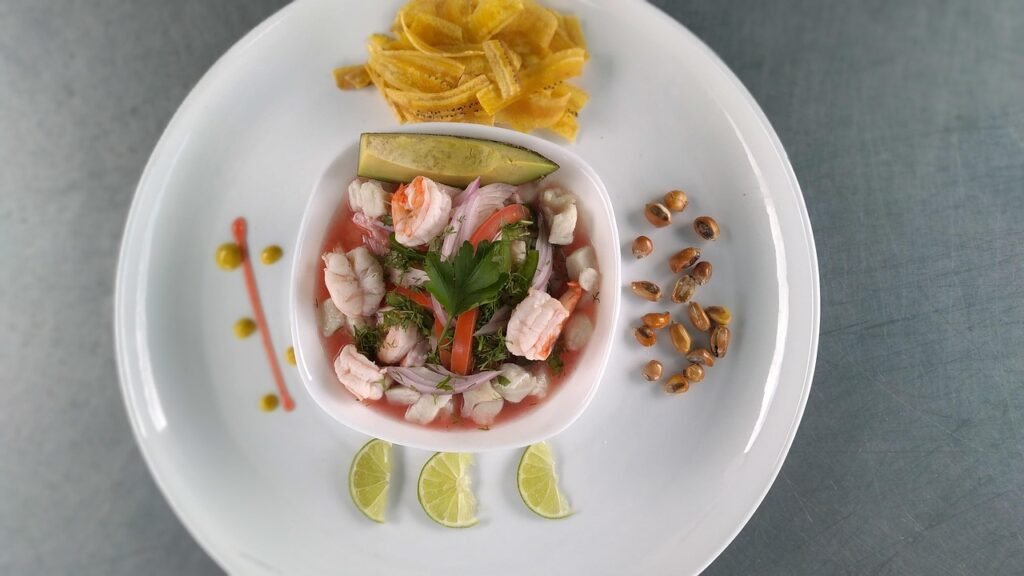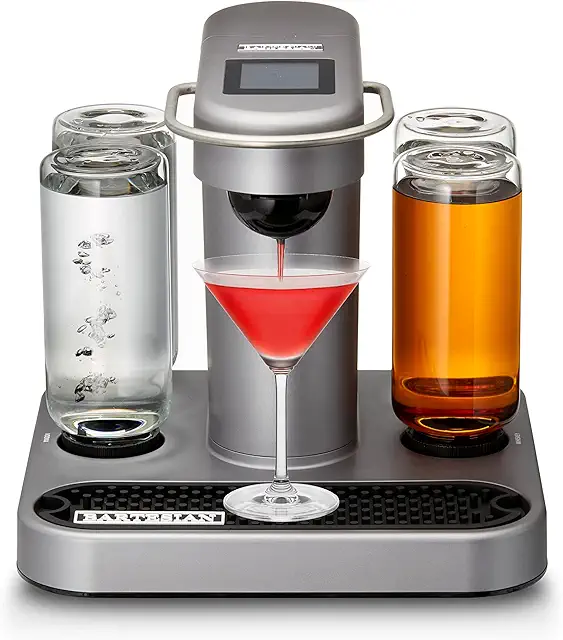
Summer is the perfect time to enjoy light and refreshing dishes, and Peruvian ceviche is at the top of that list. Made with fresh fish, vibrant vegetables, and a zesty marinade, this dish is not only delicious but also quick to prepare. Whether you’re hosting a backyard barbecue or a beach picnic, ceviche is an impressive appetizer that will wow your guests and keep things cool during those hot summer days.
Key Takeaways
- Peruvian ceviche is a light and refreshing dish, ideal for summer gatherings.
- Quick to make, this ceviche can be prepared in under 30 minutes.
- Fresh, high-quality fish is essential for the best flavor and texture.
- Serve ceviche with crunchy sides like plantain chips or tostadas for a delightful contrast.
- Explore variations of ceviche from different Latin American countries for even more flavor.
Peruvian Ceviche: The Perfect Summer Appetizer

A Light and Refreshing Dish
Peruvian ceviche is seriously the best thing to eat when it’s hot outside. It’s so light and fresh, it won’t weigh you down. Forget heavy meals; this is all about enjoying the sunshine with a dish that tastes like summer. It’s a simple mix of fresh fish, lime juice, onions, and peppers. It’s a total flavor explosion that’s also good for you. What’s not to love?
Quick Preparation Tips
Making ceviche doesn’t take forever, which is awesome. Here’s the lowdown:
- Use the freshest fish you can find. Seriously, this is key.
- Don’t marinate the fish for too long, or it’ll get weirdly rubbery. About 10-15 minutes is usually perfect.
- Prep all your veggies beforehand so you can just toss everything together.
- Taste as you go and adjust the lime juice and spice to your liking.
Honestly, the hardest part is waiting for it to be ready. Once you get the hang of it, you can whip up a batch in no time. It’s the perfect appetizer when you need something fast and impressive.
Serving Suggestions
Okay, so you’ve made your ceviche. Now what? Here are some ideas:
- Serve it in small bowls or glasses as an appetizer.
- Pile it high on tostadas for a heartier snack.
- Serve with plantain chips or sweet potato fries for dipping.
- Don’t forget a cold beer or a refreshing pisco sour to wash it all down.
Traditionally, Peruvian ceviche is served with:
| Accompaniment | Description |
|---|---|
| Sweet Potato (Steamed) | Diced and steamed, provides a sweet contrast |
| Choclo (Boiled Corn) | Large-kernel corn, adds a starchy element |
| Cancha Corn | Toasted corn kernels, for a crunchy texture |
Understanding Ceviche: A Culinary Delight

What is Ceviche?
Ceviche is more than just a dish; it’s a culinary experience. At its core, ceviche is a preparation of fresh, raw fish cured in citrus juices, most commonly lime or lemon. The acidity of the citrus essentially cooks the fish, denaturing the proteins and giving it a firm texture. It’s often mixed with other ingredients like onions, cilantro, and chili peppers to add layers of flavor. Think of it as a bright, zesty seafood cocktail that’s both refreshing and satisfying. It’s important to use the freshest fish possible, since there’s no actual cooking involved with heat.
Ceviche Variations Across Latin America
Across Latin America, ceviche takes on many forms, each reflecting local ingredients and culinary traditions. In Mexico, you might find ceviche with tomatoes, jalapeños, and avocado, often served with tortilla chips. Peruvian ceviche, on the other hand, often features a simpler preparation with red onions, habanero peppers, and is served with sweet potato or corn. Guatemalan ceviche can include a mix of fish and shrimp. The possibilities are endless, and each country brings its own unique spin to this classic dish. It’s fun to try different versions and see how the flavors change!
Ceviche’s Cultural Significance
Ceviche isn’t just food; it’s a part of the cultural identity of many Latin American countries. It’s often served during celebrations, family gatherings, and special occasions. In Peru, it’s considered the national dish, and its preparation is a source of pride. The dish reflects the region’s history, blending indigenous ingredients with influences from Spanish and Japanese cuisine. It’s a reminder of the connection to the sea and the importance of fresh, local ingredients. It’s a dish that tells a story, connecting people to their heritage and traditions.
Ceviche represents more than just a meal; it embodies a region’s history, traditions, and connection to the sea. Its variations reflect the diverse culinary landscape of Latin America, making it a dish with deep cultural roots and significance.
Choosing the Right Ingredients for Peruvian Ceviche

Best Fish Options
When it comes to Peruvian ceviche, the quality of your fish is paramount. You absolutely need the freshest fish you can get your hands on. Traditional choices include sea bass, sole, or red snapper. The fish should have a firm texture and a mild, clean flavor. Avoid anything that smells overly fishy, as that’s a sign it’s past its prime. Ask your fishmonger for recommendations; they’re the experts! Remember, the fish is ‘cooked’ by the citrus, so freshness is key to food safety and taste. fresh fish fillets are the best.
Essential Vegetables and Herbs
Beyond the fish, the supporting cast of vegetables and herbs is what really brings Peruvian ceviche to life. Here’s a breakdown:
- Red Onion: Adds a sharp, pungent bite. Soak it in saltwater beforehand to mellow the flavor.
- Aji Amarillo Peppers: These are the traditional chili peppers used in Peruvian ceviche. They provide a fruity heat that’s unique to the dish. If you can’t find them, habanero can be used sparingly.
- Cilantro: Fresh cilantro is a must for that bright, herbaceous note. Don’t skimp on it!
- Garlic: Just a touch of garlic adds depth and complexity.
Don’t be afraid to experiment with other vegetables like sweet potato or corn, which are common additions in some regions of Peru. These add a touch of sweetness and texture that complements the acidity of the lime juice.
The Role of Citrus in Ceviche
Citrus is the heart and soul of ceviche. It’s what ‘cooks’ the fish and gives the dish its signature tangy flavor. Freshly squeezed lime juice is non-negotiable. Bottled juice simply won’t do. The acidity of the lime juice denatures the proteins in the fish, effectively ‘cooking’ it without heat. The resulting liquid, known as leche de tigre (tiger’s milk), is a flavorful broth that’s often enjoyed with a spoon. The tiger’s milk is the best part!
Crafting the Perfect Peruvian Ceviche

Step-by-Step Preparation
Okay, so you want to make some killer Peruvian ceviche? It’s not as hard as it looks, trust me. First, you gotta get your hands on some super fresh fish – think sea bass or mahi-mahi. Cut it into small cubes, about 1/2 inch. Then, in a bowl, mix the fish with thinly sliced red onion, some diced chili pepper (if you’re feeling brave!), and a whole lotta lime juice. Like, enough to cover the fish completely. Don’t forget a pinch of salt and pepper. That’s the basic rundown.
Marinating Techniques
The key to great ceviche is the marinating time. You don’t want to overdo it, or the fish will get all mushy. Usually, about 10-15 minutes in the lime juice is perfect. You’ll see the fish change color – that’s how you know it’s “cooking” in the acid. Some people like to add a splash of Leche de Tigre (tiger’s milk) to the marinade for extra flavor. This is basically the leftover lime juice marinade, often blended with a bit of the fish, onion, and chili. It adds a real kick!
Presentation Ideas
Presentation matters! You can serve your ceviche in a bunch of different ways. Here are some ideas:
- Small bowls or glasses as an appetizer
- On top of lettuce leaves for a light meal
- Alongside sweet potato or corn, like they do in Peru
Don’t be afraid to get creative with your garnishes. Fresh cilantro is a must, but you could also add some avocado slices, a sprinkle of red pepper flakes, or even a drizzle of olive oil. The goal is to make it look as good as it tastes!
Here’s a simple table to help you visualize the marinating times:
| Fish Type | Marinating Time | Notes |
|---|---|---|
| Sea Bass | 12 minutes | Firm texture |
| Mahi-Mahi | 10 minutes | Softer, be careful not to over-marinate |
| Tilapia | 8 minutes | Can get mushy quickly |
Pairing Peruvian Ceviche with Complementary Dishes
Traditional Accompaniments
When serving Peruvian ceviche, think about the textures and flavors that will enhance the experience. Classic accompaniments include sweet potato (camote) and corn (choclo). These provide a nice contrast to the acidity and spice of the ceviche. Consider these options:
- Canary beans: A simple side that doesn’t overpower the ceviche.
- Tostones: Fried plantain slices for a satisfying crunch.
- Yuca fries: Another starchy option that complements the dish well.
Don’t underestimate the power of a simple side. Sometimes, the best pairings are the ones that let the ceviche shine.
Refreshing Beverages
Choosing the right drink can make or break your ceviche experience. You want something that cleanses the palate and doesn’t clash with the delicate flavors. Here are some ideas:
- Pisco Sour: A classic Peruvian cocktail that complements the dish perfectly.
- Light Beer: A crisp lager or pilsner is always a safe bet.
- Non-Alcoholic Options: Try a refreshing lime juice or sparkling water with a squeeze of lime.
Creative Side Dishes
Want to step outside the box? Here are some less traditional, but equally delicious, side dishes to consider:
- Avocado Salad: Creamy avocado provides a nice contrast to the acidity of the ceviche.
- Quinoa Salad: A healthy and flavorful option that adds some substance to the meal.
- Mango Salsa: The sweetness of mango pairs surprisingly well with the spicy and sour notes of the ceviche. You can even add a little habanero pepper for an extra kick!
Exploring the Differences: Peruvian vs. Mexican Ceviche
Flavor Profiles
When it comes to ceviche, both Peru and Mexico bring unique flavor profiles to the table. Peruvian ceviche is known for its clean, sharp taste, emphasizing the freshness of the fish and the acidity of the lime juice. It often features a spicy kick from aji amarillo peppers, creating a balance of heat and citrus. Mexican ceviche, on the other hand, tends to be more vibrant and complex, incorporating tomatoes, onions, cilantro, and sometimes even avocado. The addition of ingredients like tomato juice or hot sauce can also give it a slightly sweeter or spicier edge.
Ingredient Variations
Ingredient choices are a key differentiator between Peruvian and Mexican ceviche. Peruvian ceviche typically uses simple ingredients to highlight the quality of the fish. Common components include:
- Fresh white fish (like sea bass or flounder)
- Red onion
- Aji Amarillo pepper
- Lime juice
- Cilantro
Mexican ceviche boasts a wider array of ingredients, resulting in a more colorful and textured dish. Typical ingredients include:
- Fish or shrimp
- Tomato
- Onion
- Cilantro
- Jalapeno or serrano pepper
- Avocado (optional)
Serving Styles
The way ceviche is served also varies between the two countries. Peruvian ceviche is often served immediately after marinating, with the leche de tigre (the marinade) spooned over the fish. It’s common to see it accompanied by sides like sweet potato, corn on the cob (choclo), or cancha (toasted corn kernels). Mexican ceviche, however, is frequently served as a tacos al pastor appetizer with tortilla chips or tostadas. It might also be presented as a seafood cocktail, with a generous amount of the marinade and chopped vegetables.
Tips for Making the Best Peruvian Ceviche

Balancing Flavors
Achieving the perfect ceviche is all about balance. The interplay between the acidity of the lime juice, the heat from the chili peppers, and the freshness of the fish is what makes this dish sing. Don’t be afraid to taste and adjust as you go. A little extra lime can brighten it up, while a pinch of salt can round out the flavors. Remember, the goal is a harmonious blend where no single element overpowers the others. I like to start with a base ratio and then tweak it based on the specific ingredients I’m using that day. It’s more art than science, really.
Adjusting Spice Levels
Spice is a key component of Peruvian ceviche, but it’s important to get it right. The type of chili you use will greatly impact the heat level. Aji amarillo is a common choice, offering a fruity and moderate heat. Habaneros will bring significant heat, so use them sparingly. Remember, you can always add more spice, but you can’t take it away. Here’s a simple guide:
- Mild: Aji Amarillo (small amount)
- Medium: Serrano pepper (deseeded)
- Hot: Habanero pepper (use with extreme caution)
If you accidentally add too much spice, try adding a touch of sweetness to balance it out. A little bit of sugar or even a splash of coconut milk can help tame the heat.
Storing Leftovers
Ceviche is best enjoyed fresh, but if you have leftovers, proper storage is important. The texture of the fish will change as it continues to “cook” in the lime juice, so it’s best to consume it within a few hours. Here are some tips:
- Store in an airtight container in the refrigerator.
- Consume within 24 hours for the best quality.
- Be aware that the fish will become firmer and the flavors will intensify over time.
- Drain excess leche de tigre before storing to slow down the cooking process.
Wrap Up Your Summer with Peruvian Ceviche
So there you have it! Peruvian ceviche is a fantastic way to enjoy fresh flavors this summer. It’s quick to whip up and perfect for any gathering, whether you’re at a backyard BBQ or chilling by the beach. Just remember, it’s best served fresh, so make it right before you dig in. And if you have any leftovers, just store them properly and add a splash of lime juice to revive that zesty taste. Trust me, once you try this dish, it’ll become a staple in your summer menu. Enjoy the sunshine and happy eating!
Frequently Asked Questions
What is Peruvian ceviche?
Peruvian ceviche is a dish made from fresh, raw fish that is marinated in lime juice. It often includes vegetables like onions and peppers, making it a light and tasty summer meal.
How long does it take to prepare ceviche?
You can make ceviche in under 30 minutes! It’s a quick and easy dish that’s perfect for hot summer days.
What type of fish is best for ceviche?
The best fish for ceviche is firm, white fish like cod, halibut, or mahi-mahi. Freshness is key since the fish is not cooked with heat.
Can I make ceviche ahead of time?
It’s best to serve ceviche right away. If you have leftovers, store them in the fridge and eat them within two days.
What should I serve with ceviche?
Ceviche is great with crunchy snacks like plantain chips or tostadas. You can also serve it with sweet potatoes or corn.
What’s the difference between Peruvian and Mexican ceviche?
Peruvian ceviche often has a stronger citrus flavor and uses different types of peppers compared to Mexican ceviche, which may include more spices and different ingredients.

